Key takeaways:
- Hospital ministry emphasizes the spiritual and emotional needs of patients, bridging the gap between medical treatment and holistic care.
- Relaxation techniques, such as mindfulness and deep breathing, can significantly enhance the healing process and empower patients during treatment.
- Creating a calming environment with elements like soft lighting and soothing sounds fosters a positive atmosphere that aids recovery.
- Seeking professional assistance for relaxation can provide tailored techniques and foster a sense of community among patients.
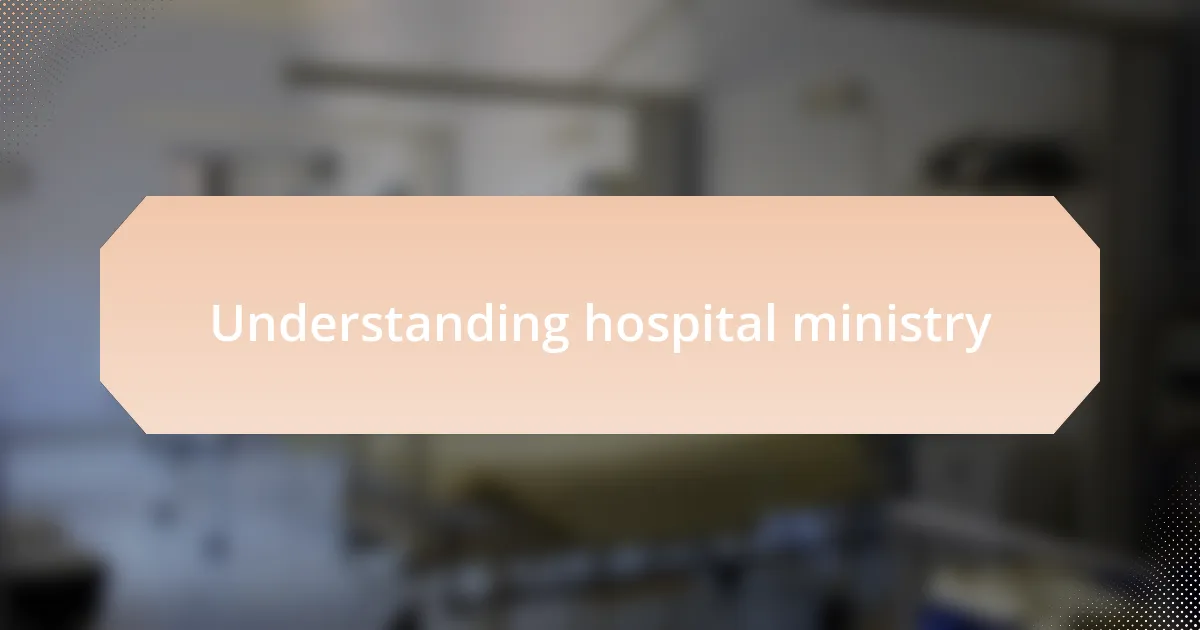
Understanding hospital ministry
Hospital ministry is a profound aspect of healthcare that emphasizes the spiritual and emotional needs of patients. I remember a time when I sat with a patient who was grappling with a terminal diagnosis; the connection we made during that conversation was both humbling and powerful. It led me to question how often we overlook the importance of spiritual care in settings where healing seems purely physical.
One striking element of hospital ministry is its focus on providing hope and comfort in the midst of fear and uncertainty. I’ve seen how a simple prayer or a moment of reflection can transform the atmosphere of a room. Have you ever noticed how a shared moment of vulnerability can create lasting bonds? It’s this very connection that fuels the essence of hospital ministry, where spiritual leaders act as conduits of compassion amidst clinical routines.
Moreover, hospital ministry bridges the gap between medical treatment and holistic care. I often reflect on how the most meaningful moments occur when patients realize they are not alone in their journey. This realization brings a sense of calm, making one wonder: how can we better support those undergoing treatment? It’s a reminder of the importance of nurturing the spirit as we seek to heal the body, highlighting that a comprehensive approach to care is not only beneficial but essential.
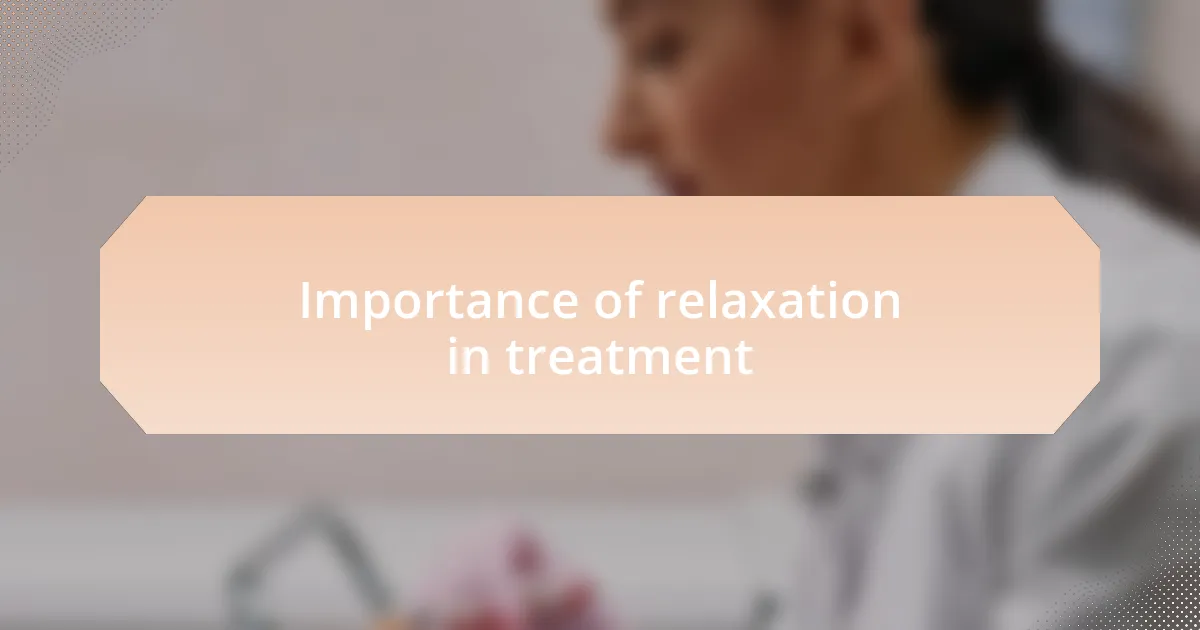
Importance of relaxation in treatment
Relaxation plays a crucial role in the treatment process, as it helps alleviate stress and anxiety that can accompany medical care. I recall a moment with a patient who found solace in deep breathing exercises before a procedure. Watching her relax visibly transformed her mindset, turning fear into a quiet confidence. Isn’t it amazing how something as simple as breath can recalibrate our emotional state?
Furthermore, engaging in relaxation techniques can enhance the body’s ability to heal. For instance, studies have shown that patients who practice mindfulness often experience lower pain levels and better overall recovery. I remember encouraging a fellow patient to try guided imagery; the shift in her face from tension to peace was truly striking. It made me wonder, how many more patients could benefit from this simple yet effective approach?
Ultimately, and perhaps most importantly, relaxation fosters a sense of control during treatment, empowering patients to take an active role in their health journey. When I guided a group in meditation, many expressed that they felt more connected to their bodies. That connection not only brings emotional peace but also strengthens the spirit, cultivating resilience. Don’t you think this newfound empowerment can significantly impact one’s outlook on treatment?
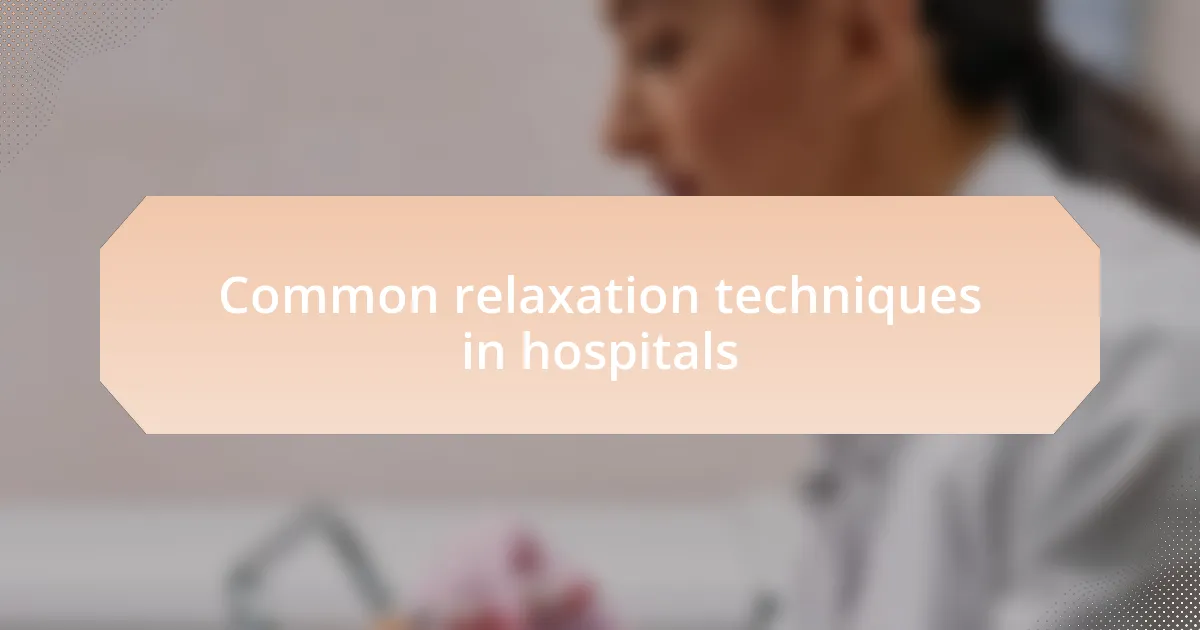
Common relaxation techniques in hospitals
Common relaxation techniques in hospitals often include deep breathing exercises, guided imagery, and progressive muscle relaxation. I once led a group of patients in deep breathing, and you could almost feel the collective sigh of relief in the room. It struck me how a simple technique like focusing on breath could create an instant sense of calm, as if the air itself held the power to lighten burdens.
Another effective technique I’ve witnessed is guided imagery, where patients visualize serene landscapes or comforting scenarios. I remember a patient who envisioned a peaceful beach, and as she spoke, the tension in her shoulders seemed to melt away. It made me ponder, how can our minds craft soothing escapes that aid in healing?
Progressive muscle relaxation is another powerful tool, allowing individuals to consciously release tension from each muscle group. I’ve seen patients start this practice with furrowed brows and clenched fists, only to transform into expressions of tranquility by the end. Doesn’t it amaze you how awareness and intention can shift one’s physical state so profoundly?
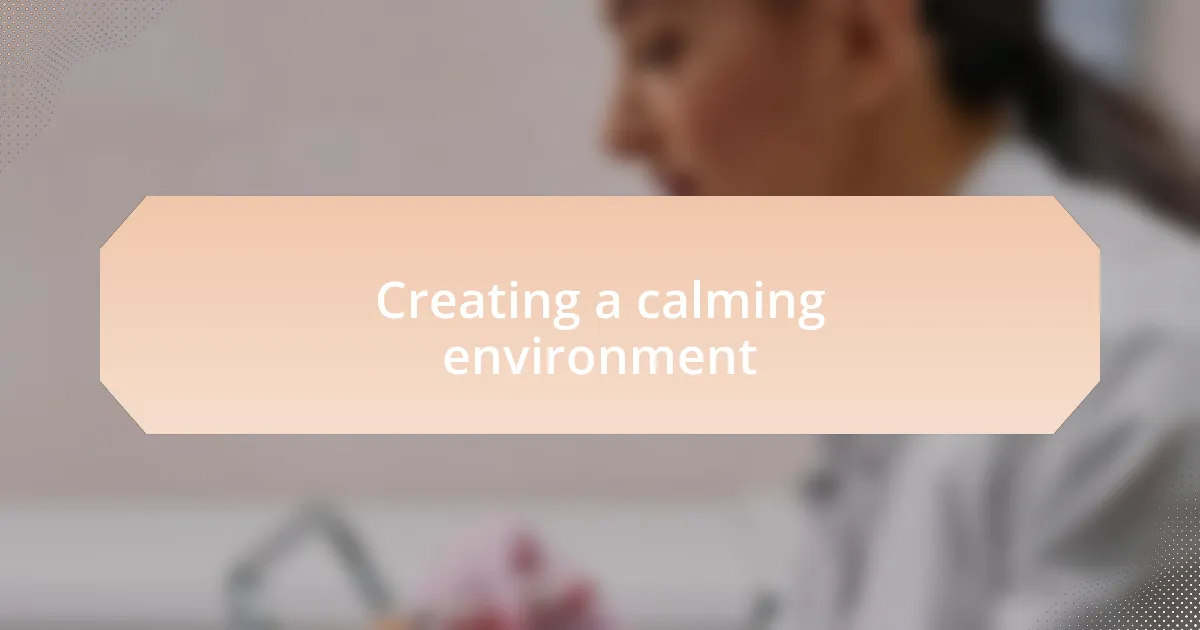
Creating a calming environment
Creating a calming environment is essential in a hospital setting, where stress and anxiety can often dominate the atmosphere. I recall a time when I helped arrange a room specifically for comfort: soft lighting, soothing colors, and gentle music played in the background. The change was palpable; it was as if the space itself breathed a sigh of relief, inviting both patients and staff to pause and feel a little lighter amidst the challenges.
In my experience, even small additions can make a significant difference. I vividly remember placing a few potted plants in a waiting area, and almost immediately, the mood shifted. Patients began to interact more, exchanging smiles and stories, which led me to wonder: could nature’s simple beauty be a powerful ally in healing?
Sound also plays a crucial role in creating a calming environment. To illustrate, I once experimented with a sound machine that emitted gentle rain sounds, which dramatically transformed the atmosphere. The patients who experienced it often remarked how it made them feel safe and cocooned. Isn’t it fascinating how certain sounds can evoke peace and unlock a sense of safety in unfamiliar surroundings?
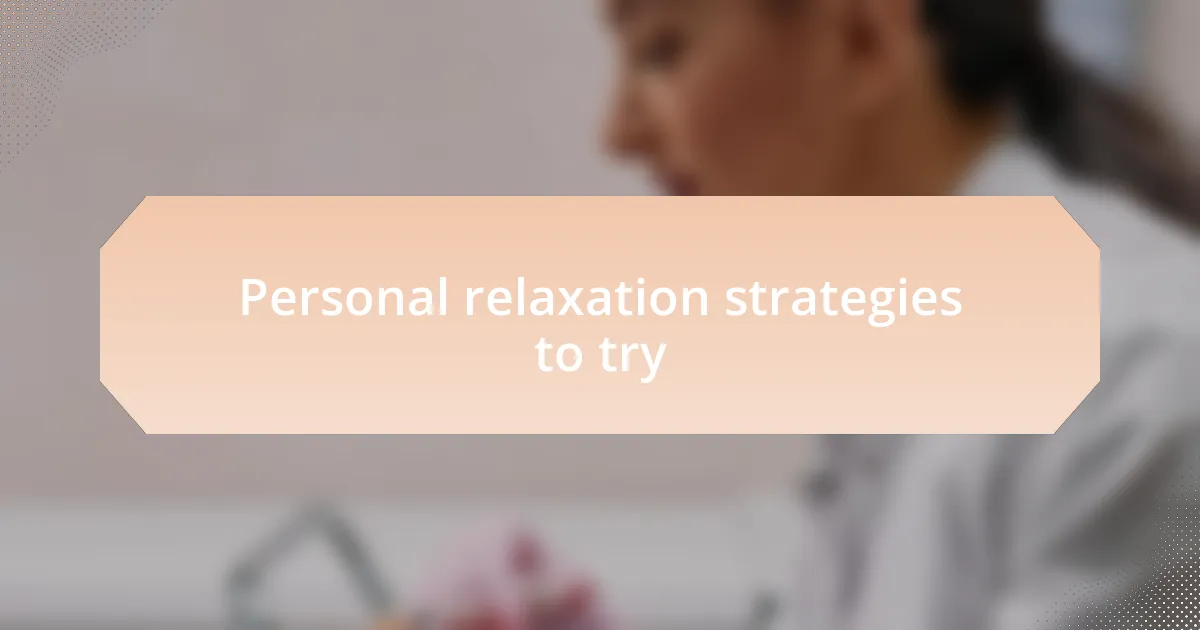
Personal relaxation strategies to try
Finding personal relaxation strategies can be a game-changer during treatment. One method I often turn to is mindfulness meditation. I remember sitting quietly in a hospital room, focusing on my breath and letting thoughts drift away like leaves on a stream. This simple act allowed me to reclaim a sense of control amidst uncertainty, prompting me to ask: have you ever experienced that moment of stillness that washes over you when you just let go?
Another technique that has worked wonders for me is journaling. On particularly stressful days, I would jot down my thoughts and feelings, transforming confusion into clarity. The act of writing felt cathartic, almost like conversing with a trusted friend. I still look back at those notes and smile, realizing how powerful self-reflection can be. Why not try setting aside a few moments each day to capture your own thoughts on paper?
Lastly, I’ve found that engaging in light stretching or gentle yoga can re-energize the body while calming the mind. Just the other day, I joined a group session in a rehab facility, and although it felt a bit awkward at first, I quickly noticed how much lighter I felt afterward. It made me wonder: might these movements be more than just exercises, but instead, a bridge to self-awareness and relaxation?
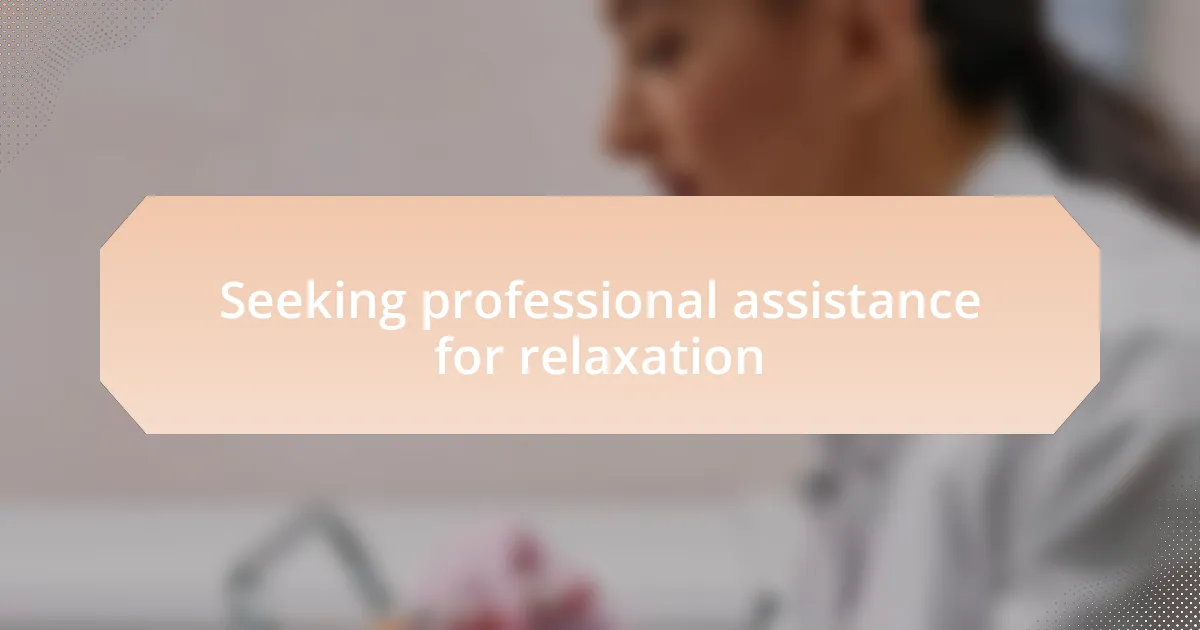
Seeking professional assistance for relaxation
Seeking professional support for relaxation can elevate one’s self-care routine during treatment. I vividly recall the first time I attended a guided relaxation session led by a therapist; the soothing voice and structured techniques helped me release tension I didn’t even realize I was holding. Have you ever felt that gentle release when someone else guides you to relax? It’s remarkable how much more effective relaxation can be when someone knowledgeable steers the process.
Connecting with a professional can also open doors to specialized methods tailored to individual needs. I started working with a licensed therapist who introduced me to biofeedback techniques, teaching me how to control physiological functions like heart rate and muscle tension. This experience not only empowered me but helped deepen my understanding of my body’s responses. Isn’t it fascinating to learn how much influence we can wield over our own relaxation?
Another invaluable aspect of seeking professional assistance is the sense of community it fosters. I remember joining a support group where relaxation techniques were a shared focus. The camaraderie and collective experiences made the challenges feel less daunting, and I discovered that I wasn’t alone in my journey. Have you considered that seeking help might also mean finding strength in numbers?